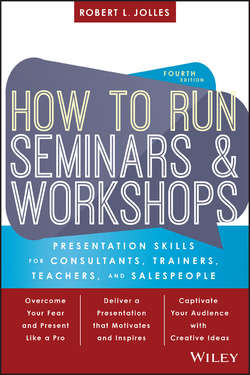How to Run Seminars and Workshops

Реклама. ООО «ЛитРес», ИНН: 7719571260.
Оглавление
Jolles Robert L.. How to Run Seminars and Workshops
PREFACE
ACKNOWLEDGMENTS
PART I. GETTING STARTED
CHAPTER 1. CREATING A SEMINAR BUSINESS
Branding Yourself
General versus Closed Seminars
Keynotes
Seminars and Workshops
Marketing Your Programs
Speakers' Bureaus
Third-Party Marketing
Summary
CHAPTER 2. WORKING WITH ADULT AUDIENCES
Create an Atmosphere Conducive to Training
Build and Maintain Interest
Capitalize on the Experience of Adult Trainees
Structure Your Presentation Logically
Use Activity to Promote Involvement
Set Definite Goals
Use Repetition to Increase Retention of Critical Information
Tell Trainees What You Require of Them
Motivate Adult Trainees to Learn
Make the Presentation Visual
Satisfy the Information Needs of the Trainees
Summary
CHAPTER 3. RECOGNIZING TRAINEES' LEVELS OF BEHAVIOR
Level One – The Unconscious Incompetent
Level Two – The Conscious Incompetent
Level Three – The Conscious Competent
Level Four – The Unconscious Competent
The Four Levels of Behavior in Action
The Next Level
Summary
CHAPTER 4. THE PERSONALITY PARADE. TRAINING ALL DIFFERENT TYPES OF PEOPLE
The Loner Trainee
The Quiet Trainee
The Amiable Trainee
The Discouraged Trainee
The Enlightener Trainee
The Joker Trainee
The Reliant Trainee
The Sniper
Some Closing Thoughts
Summary
CHAPTER 5. THE PACE RACE. HOW TO TRAIN GROUPS WITH DIVERSE NEEDS
How to Pace a Course for a Large Group with Wildly Diverse Needs
What Not to Do when Training Diverse Groups
How to Work with the Slowpoke
How to Work with the Whiz Kid
Summary
CHAPTER 6. ANATOMY OF AN 8:00 A.M. START. FINALIZING ON-SITE PREPARATIONS
7:00 a.m.: Arrive Early to Ensure Everything Is Ready
7:30 a.m.: Arrange Who Sits Where
7:45 a.m.: It's Time for Music to Create a Relaxed Atmosphere
7:50 a.m.: Greeting Your Trainees
8:00 a.m.: Let's Get Ready to Rumble!
8:10 a.m.: Time to Break the Ice
8:30 a.m.: Expectation Time
Summary
PART II. DELIVERY: THE ART OF MAKING GREAT PRESENTATIONS
CHAPTER 7. THE SECRET OF SUCCESS. SELLING YOUR PRESENTATION
Introducing the UPPOPPR Process
Mastering the UPPOPPR
Introducing the UPPOP Process
Summary
CHAPTER 8. THIRTY TIPS ON MAINTAINING INTEREST
What to Do about Sleepy Trainees
Summary
CHAPTER 9. THE ART OF EFFECTIVE QUESTIONING. GETTING TRAINEES INVOLVED
Types of Questions
Preparing and Coaching Trainees to Answer Questions
Techniques for Asking Questions
Do's and Don'ts of Questioning
Summary
CHAPTER 10. USING VISUAL AIDS
Flip Charts
Video
Objects for Demonstrations
Pointers
Dos and Don'ts
Some Final Thoughts
Summary
CHAPTER 11. TECHNOLOGY AND TRAINING
The Technical Revolution
Presentation Software
Laptop Computers
Projectors
Additional Projector Technology
Troubleshooting
Other Considerations
Music
Electronic Whiteboards and Copy Boards
Document Cameras
Summary
CHAPTER 12. TAKING YOUR TRAINING ONLINE
The Challenges of Online Training
The Strengths of Online Training
Natural Fits for Online Delivery
Tips for Successful Online Delivery
Tips for Successful Online Videos
Letting Others Know about Your Online Presence
Summary
CHAPTER 13. GIVING FEEDBACK AND COACHING
Pitfalls to Avoid
Giving Feedback without Intimidating Trainees
Coaching Using the Three Ss
Summary
CHAPTER 14. TRICKS OF THE TRADE
Summary
PART III. IMPROVING THE TRAINING PROCESS
CHAPTER 15. INSIDE THE MIND OF A PROFESSIONAL SPEAKER. HOW TO PRESENT YOUR BEST SELF
Always Present a Positive and Enthusiastic Attitude
Don't Advertise Any Lack of Experience
How to Handle Illness on the Job
Surviving with a Split Personality
Stay in Training Shape
Be Confident, Not Arrogant
Coping with Doubt
Working with Anxiety
Summary
CHAPTER 16. THE VALUE OF GOOD TRAINING. HIRING EFFECTIVE TRAINERS
Meet the New Breed of Presenters
Whom to Hire
Summary
CHAPTER 17. AVOIDING THE TRAINING TRAP. PROBLEMS WITH RELEVANCE AND RESPECT
How to Build Credibility and Gain Respect for Training
Training Can't Solve All Business Problems
Validating Your Training Programs
Summary
CHAPTER 18. DEVELOPING A TRAINING STAFF
Emphasize the Quality of Your Training Programs
Make Sure Trainers Work with the Curriculum Developers
Promote Consistency in Course Content and Training Style
Summary
CHAPTER 19. EVALUATION AND SUPPORT
Evaluating Trainees
Evaluating the Trainer
Advance Preparation Using Preschools
Realistic Expectations
Summary
CHAPTER 20. ADVENTURES IN CROSS-TRAINING
Factors to Consider before Cross-Training Trainers
How to Cross-Train a New Presenter
Don't Be a Perfectionist
Power and Its Many Misuses
Summary
EPILOGUE: WHAT'S NEXT?
WILEY END USER LICENSE AGREEMENT
Отрывок из книги
About 25 years ago, I wrote the first edition of this book and invited you into the world of seminars and workshops. Whether you are a professional speaker, trainer, seminar leader, guest speaker, or just someone who occasionally must deliver an idea by addressing a group of people, this book was created for you. From marketing and preparation to all aspects of delivery, this book will guide you through the many nuances that will allow you to direct a group of strangers so that they come together as a team and accomplish a common goal.
A lot has changed over the years. More and more people are tasked with presenting information to others. These presentations are often delivered to a green dot on the top of a monitor and seen by others many miles, and sometimes continents, away.
.....
You can spare yourself the time and trouble of creating a proposal because the self-publishing companies will be selling you to allow them to do the work. Why not? They are not taking any risk whatsoever. It is purely business. Most print on demand, and some will save you a few extra dollars and print as many as you would like.
Wait. There's more. For each book you sell, you now stand to make five to six times more money. More money per sale, no begging a publisher, not detectable by your average reader, and quicker to market are some pretty powerful selling points for self-publishing. So, what's the catch?
.....